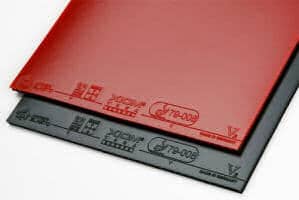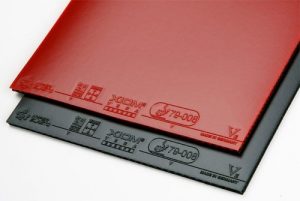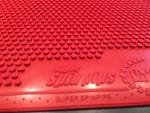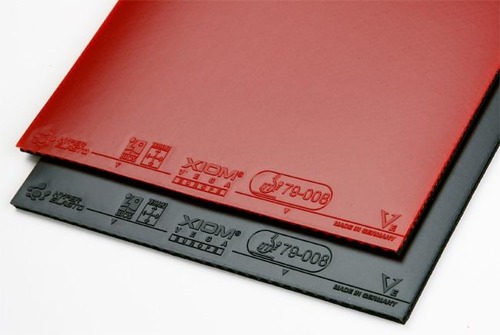
This article described the difference in properties between red and black table tennis rubbers. Although for some rubbers the difference is insignificant, for others there is a distinct difference that players can take advantage of. If you’re aware of the difference, you can decide which is the best option for your new custom table tennis bat. Even if the difference can give you one extra point in a game, it’s worth it, isn’t it?
 Why do we need a red & a black rubber on either side?
Why do we need a red & a black rubber on either side?
In the early days of table tennis, you used to be able to use any colour of rubbers you like, and the same on both sides if you wished. However as the research into different rubber technologies progressed, the variety of different rubbers increased, so players with different rubbers on either side could use this as part of a strategy. Players could ‘twiddle (flip over the bat), and with the same stroke produce very different shots, depending on the rubber they used on either side.
Although top players could usually hear the difference in sound as the ball was struck, this became very tricky in noisy environments, and gave the combination players’ a distinct advantage.
In the 1980s the ITTF brought in new table tennis rules for rackets, stating that one side of the racket must be red, and other black. The wording of the current rule is:
2.4.6 The surface of the covering material on a side of the blade, or of a side of the blade if it is left uncovered, shall be matt, bright red on one side and black on the other.
Since players are allowed to inspect the opponent’s bat before the match commenced, they would know which rubber was which colour, allowing them to adjust.
For what type of rubbers does the colour make a difference?
For most inverted (smooth) European / Japanese table tennis rubbers the difference between red and black is almost insignificant, so just choose the combination that you prefer, or that you’re used to. However for many Chinese rubbers, and also pimple rubbers and antispin, the difference can be quite significant, so the choice of colour should be considered,to give you the best outcome for your game. The properties are summarised in a table below:
| Rubber Type: | Popular Example: | Difference: |
| Inverted Euro/Japanese Non-Tacky | Tenergy 05 | insignificant |
| Inverted Chinese Non-Tacky / mild tack | LKT Pro XT | Minor – black tackier |
| Inverted Tacky | Hurricane 3 Neo | Significant – black tackier, red faster |
| Short pimples | TSP Spectol | insignificant |
| Long pimples | SpinLord Dornenglanz | Significant – red better reversal |
| Anti Spin | Nittaku Best Anti | Significant – red better reversal |
Inverted Euro/Japanese Non-Tacky:
In general for non-tacky Euro/Japanese table tennis rubbers, the difference is so low it would be insignificant for most people
Inverted Chinese Non-Tacky:
For the majority of Chinese-made rubbers, the difference is a little more noticeable. The red tends to be a little faster, the black a little slower but more grippy.
Inverted Tacky:
For tacky (sticky) table tennis rubbers, the difference quite noticeable. For more speed and less sensitivity to incoming spin, choose RED. For higher grip / tack choose the black rubber. Note that if you don’t put in the effort to keep the black rubber sticky (cleaner/protection sheet), it will lose it’s tackiness, and will become very similar to the red sheet, defeating the purpose of choosing this colour. Note also that the quality control for some Chinese rubbers is not very good, which means you can get a lot of variation between one sheet and another, and you could come across a red sheet that’s tackier than a black sheet.
https://www.youtube.com/watch?v=8nFRTNgRrD0
 Short pimples:
Short pimples:
The purpose of these rubbers is usually to control or hit through the spin, not to get extreme spin or spin reversal, so the effect of the colour is insignficantly for most people. If you want more grip, you’d pick a spinnier short pimple, while if you want less grip and more ‘sink effect’, you’d pick a less spinny short pimple.
Long Pimples:
Long pimples are mainly used for controlling the spin of the ball, or reversing it. The lower grip of the red sheet gives the best reversal, and since the red rubber tends to be a little stiffer as well, it absorbs the pace better. So for close-in blockers/pushers, usually a red sheet in OX (no sponge) is preferred. If you’re more a chopper, and want to add your own spin, then the little extra grip of the black pimple might actually be preferable.
Antispin:
For most antispin rubbers, players want as low as possible grip, to reduce the effect of the incoming spin, and to produce the most awkward balls for the opponent. For the lowest possible grip, red would be the best choice. However some antispin players actually want a little bit of grip. so depending on the which antispin rubber you choose, the black might also be a good option.
Conclusion
So, does it make a difference for you which colour of table tennis rubbers you choose? Well it may not, and even if you choose the colours that are not optimum, you may adjust to compensate. However if you’re going to make a change anyway, and do want the optimum choice of colours just to get that last bit of advantage out of your equipment, it’s worth considering the options. Hopefully this article has given you enough information to make an informed choice.




As I recall the ITTF didn’t go to the red/black rule right away – it first tried a two distinct colour rule. This meant that players could use a combo that was say orange/red which still could cause problems for your opponent given the speed of the game. The ITTF soon remedied this problem with the stricter red/black rule.
Thanks Kevin, I really appreciate the additional information!